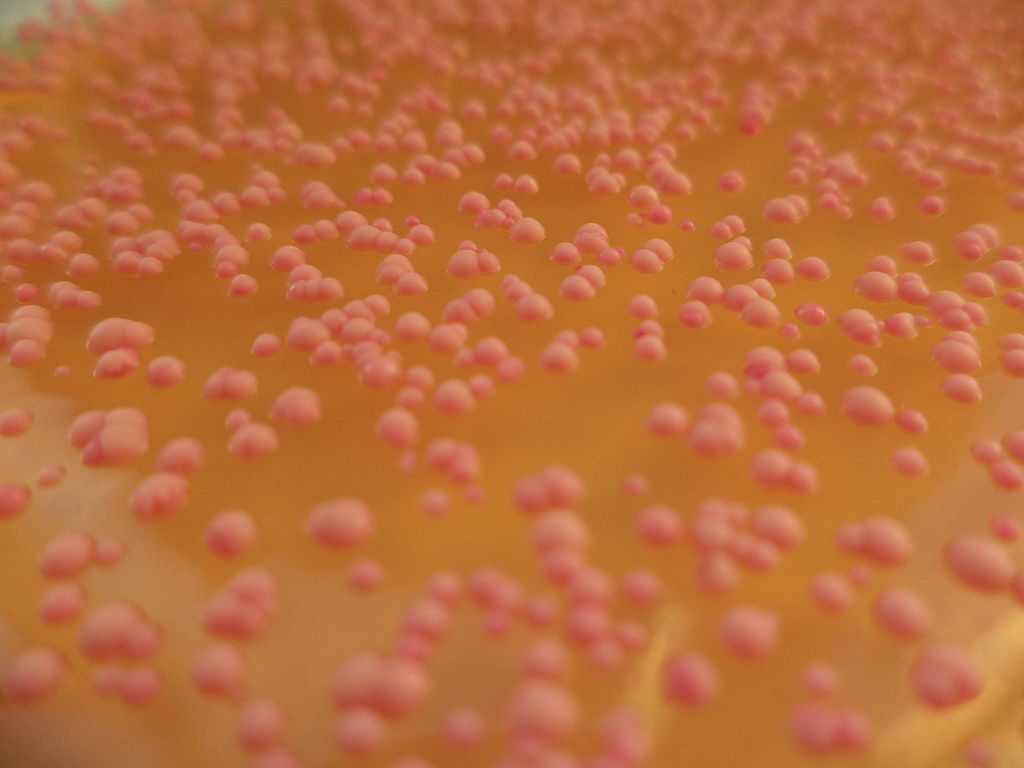There are a lot of ways a wine can be spoiled, one of which is an infection by the yeast Brettanomyces bruxellensis – or Brett. When a wine is infected with Brett, is can exhibit undesirable sensory characteristics such as band-aid, barnyard, mousy, or other similar off-scents. On the other hand, when present in very low levels, some describe the sensory change as more desirable – adding a sense of spiciness or leather to the wine. It’s debatable whether or not Brett is good or bad, though one can argue it all depends on how bad the infection is as well as the sensitivity of the taster. On average, studies have shown that more people tend to dislike Brett character in wine than those who prefer it.
The sensory characteristics associated with a Brett infection are caused by the synthesis of at least three compounds: 4-ethlyphenol (4-EP), 4-ethylguaiacol (4-EG), and isovaleric acid (IA), with each having a specific sensory threshold, the values of which are the minimum required for a taster to notice them in the wine.
Whether or not someone can detect Brett in a wine varies for many reasons, including any formal wine training or expertise held by the taster. In fact, studies have shown that those with more experience in wine, particularly those with a formal wine education or training, can detect lower levels of Brett than the average person on the street with little to no wine knowledge. Additionally, the type of wine that is infected with Brett can also influence it’s perception by the taster (red vs white, oak vs no oak, etc.).
A relatively new study, published in February 2019 in the journal Food Research International, aimed to evaluate how specific wine characteristics influence perception of Brett character in wine, and also how wine knowledge might alter this perception. Specifically, the study looked at how oak and green characteristics influence the perception of Brett in wine, as well as the length of the finish.
Brief Methods
To imitate a Brett infection, metabolites linked to the spoilage were added to base wines: 4-EP, 4-EG, and IA. For simplicity, I’ll refer to this addition of metabolites as “Brett added” in this section.
A total of 7 treatments were used in this study:
- Control wine (no treatment)
- Wine with “green” characteristics added, no Brett
- Wine with “oaky” characteristics added, no Brett
- Wine with “green” characteristics, “Brett added” at low levels
- Wine with “oaky” characteristics, “Brett added” at high levels
- Base wine (no oaky or green character), “Brett added” at low levels
- Base wine (no oaky or green character), “Brett added” at high levels.
The base wine used in this study was Charles “Two Buck Chuck” Shaw Shiraz.
To get “green” characteristics into some treatments, 3-isobutyl-2-methoxypyrazine was added to the wine (final concentration 20ng/L).
To get “oaky” characteristics into some treatments, whiskey lactone was added to the wine (final concentration 23.8mg/L).
Standard chemical analyses were performed on all 7 wine treatments (ethanol, titratable acidity, pH).
Sensory analysis was performed by participants recruited at Washington State University (105 total: 58 women, 37 men; between 21 and 86 years old, mean 38 years), with the requirement that they drink wine at least one or two times per month.
In order to determine how Brett is perceived by consumers, the Temporal Check-All-That-Apply” (TCATA) method of study was employed. This methodology has been used by other studies evaluating wine sensory characteristics, and is a relatively straight-forward procedure. Basically, there is a list of characteristics and the taster must check or uncheck any of those characteristics that they find (or do not find) upon tasting a given wine.
Participants evaluated each wine using the ‘check all that apply’ methodology, as well as ranking methods for both flavor and mouthfeel characteristics. Overall liking was also evaluated. For space considerations, I’ll leave out the details of the tasting design, but if you’d like to know, just ask and I can give some more details if needed.

Participants level of wine knowledge was evaluated via a questionnaire where they were subsequently characterized as having either low, medium, or high wine knowledge.
Selected Results
- 4-EP, 4-EG, and IA were below detection threshold levels in the base wine.
- 48% of participants were considered to have low wine knowledge, 42% medium wine knowledge, and 10% high wine knowledge.
- “Fruity” was noted more often in base wines than wines with Brett metabolites added.
- The higher the concentrations of Brett metabolites, the fewer notes of “fruity” in the wines.
- “Fruity” was always noted less often in wines treated with high levels of Brett metabolites, regardless of the green or oaky treatment.
- Characteristics associated with Brett metabolites were significantly lower in base wines than all wines treated with these metabolites.
- “Green” was used more often in the wines supplemented with green aroma characteristics, though as Brett metabolites were added, these notes of “green” decreased.
- “Oaky” as used more often in the wines supplemented with oaky aroma characteristics, and the addition of Brett metabolites did NOT decrease the frequency of oaky notes found in the wines.
- In the oak treatments, “smoky” notes increased as Brett metabolite concentrations increased.
- In the oak treatments, “band-aid” notes were significantly lower than the base wines with Brett metabolites added.
- In the green treatments, “band-aid” notes were higher with higher concentrations of Brett metabolites.
- Green and oaky characteristics presented themselves earlier on during the tasting event, while characteristics associated with Brett metabolites occurred more toward the finish.
- PCA analysis revealed wines separated into different groupings based on their flavor/aroma profiles.
- Those wines with high levels of Brett metabolites all shared similar sensory characteristics and were lumped close to one another.
- The “green + Brett metabolite” treatment had the highest number of notes for “sweaty” and “smoky”.
- “Fruity” character was not statistically different between the base wine and the oaky wine with low levels of Brett metabolites added.
- The “oak + low Brett metabolite” treatment had significantly fewer notes of “leather”, “Band-aid”, and “smoky” compared with the “green + low Brett metabolite” treatment.
- “Band-aid”, “smoky”, and “leather” notes were always lower in wine samples treated with oak than with base or green wines.
- Duration of time when aroma/flavor characteristics were noted in the mouth was the shortest for the base wine, and increased in time as concentrations of Brett metabolites increased.
- The base wine was “liked” by participants significantly more than all other wine treatments (“liked moderately”).
- Wines containing low levels of Brett metabolites were liked a bit less than the base wine (“neither like nor dislike”).
- The least liked wine was the “green + high Brett metabolite” treatment (“dislike slightly”).
- Participants with more wine experience “liked” the wines less than participants with less wine experience.
- PCA analysis revealed three groupings related to participant liking of the wines.
- One group didn’t like any of the wines that had Brett metabolites in them.
- Another group had higher liking scores than the previously mentioned group, with the base wine and the base wine plus low Brett metabolites as their most liked wines.
- The third grouping only did not like the base plus high Brett metabolites and green plus high Brett metabolites treatment.
- The first group (the ones who didn’t like any wines with Brett metabolites in them) had the most participants with higher wine knowledge.
Conclusions
Overall, this study provides some insight into consumer acceptance of Brettanomyces infections in wine, adding to the growing literature on the subject.
In general, consumers tended to prefer the wines with no Brett metabolites added, though there was a subset of participants who didn’t mind the wines with low levels of Brett metabolites added. For most participants, having higher levels of Brett metabolites was not desirable.
This study also compared the effects of green and oaky characteristics on the perception of Brett in wines. Results showed that “Brett-infected” wines treated with whiskey lactones for “oak” were in general much more acceptable than “green” wines with the Brett metabolites added. This suggests that oak may play a role in masking the undesirable Brett characteristics, making oak treated wines more acceptable to consumers when infected with Brett than a green or non-oaky wine.

In terms of consumer liking, results from this study indicated that consumers prefer no Brett, though a subset of consumers definitely don’t mind wines with lower levels of Brett. The results also indicate that those with more wine knowledge tended to dislike Brett-infected wines more than consumers with less wine knowledge.
It would be interesting to see this study with a greater number of wine styles, in addition to a larger sample size. “Two Buck Chuck” was the only wine used, albeit it did undergo several different treatments. Would a Two Buck Chuck with high levels of Brett present be accepted/not accepted the same as a higher quality wine that was infected with Brett? It would be interesting to see how different wines infected with Brett are accepted by consumers, though this study would suggest that the more oaky the wine, the more accepted it will be due to supposed “masking” of Brett flavors by the oak.
To sum up this study in just one sentence: as long as the wine has a lot of oak characteristics, it’ll probably be more accepted by consumers if infected by Brett compared to a wine with more green characteristics that is equally as infected. Additionally, a little bit of Brett may not be so bad after all, though no Brett is the most preferred wine “style”.
Source:
Schumaker, M.R., Diako, C., Castura, J.C., Edwards, C.G., and Ross, C.F. 2019. Influence of wine composition on consumer perception and acceptance of Brettanomyces metabolites using temporal check-all-that-apply methodology. Food Research International 116: 963-972.

